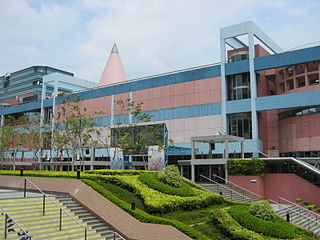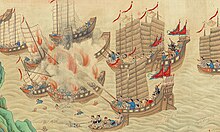
Wan Chai is located at the western part of Wan Chai District on the northern shore of Hong Kong Island, in Hong Kong. Its other boundaries are Canal Road to the east, Arsenal Street to the west and Bowen Road to the south. The area north of Gloucester Road is often referred to as Wan Chai North.

Central, also known as Central District, is the central business district of Hong Kong. It is located in the northeastern corner of the Central and Western District, on the north shore of Hong Kong Island, across Victoria Harbour from Tsim Sha Tsui, the southernmost point of Kowloon Peninsula. The area was the heart of Victoria City, although that name is rarely used today.

The Maritime Museum of the Atlantic is a maritime museum located in downtown Halifax, Nova Scotia, Canada.

Murray House is a Victorian-era building in Stanley, Hong Kong. Built in the present-day business district of Central in 1846 as officers' quarters of the Murray Barracks, the building was moved to the south of Hong Kong Island during the 2000s. This building has become an iconic landmark in Hong Kong. After housing the Hong Kong Maritime Museum, now in Stanley, it is now home to restaurants and shops.

Hong Kong Heritage Museum is a public museum of history, art and culture in Sha Tin, Hong Kong, located beside the Shing Mun River. The museum opened on 16 December 2000. It is managed by the Leisure and Cultural Services Department of the Hong Kong Government. The six permanent exhibits and the original temporary exhibits were designed by design firm Reich+Petch along with Lord Cultural Resources.

The South Street Seaport is a historic area in the New York City borough of Manhattan, centered where Fulton Street meets the East River, within the Financial District of Lower Manhattan. The Seaport is a designated historic district. It is part of Manhattan Community Board 1 in Lower Manhattan, and is next to the East River to the southeast and the Two Bridges neighborhood to the northeast.

The Port of Hong Kong located by the South China Sea, is a deepwater seaport dominated by trade in containerised manufactured products, and to a lesser extent raw materials and passengers. A key factor in the economic development of Hong Kong, the natural shelter and deep waters of Victoria Harbour provide ideal conditions for berthing and the handling of all types of vessels. It is one of the busiest ports in the world, in the three categories of shipping movements, cargo handled and passengers carried. This makes Hong Kong a Large-Port Metropolis.

The San Francisco Maritime National Historical Park is located in San Francisco, California, United States. The park includes a fleet of historic vessels, a visitor center, a maritime museum, and a library/research facility. Formerly referred to as the San Francisco Maritime Museum, the collections were acquired by the National Park Service in 1978. The San Francisco Maritime National Historical Park was authorized in 1988; the maritime museum is among the park's many cultural resources. The park also incorporates the Aquatic Park Historic District, bounded by Van Ness Avenue, Polk Street, and Hyde Street.

The Hong Kong Science Museum is a public science museum in Tsim Sha Tsui East, Kowloon, Hong Kong, located next to the Hong Kong Museum of History.

Keying was a three-masted, 800-ton Fuzhou Chinese trading junk which sailed from China around the Cape of Good Hope to the United States and Britain between 1846 and 1848. Her voyage was significant as it was one of the earliest instances of a Chinese sailing vessel making a transoceanic journey to the Western world. It served as a cultural exchange and offered Western audiences a glimpse into Chinese maritime traditions and craftsmanship.

The Hong Kong Space Museum is a public astronomy and space science museum located in Tsim Sha Tsui, Hong Kong. Opened on 8 October 1980, it is managed by the Leisure and Cultural Services Department of the Hong Kong Government. The building is notable for its hemispherical shape, which contains a planetarium, the only one in Hong Kong. The main facilities of the museum are located in a building next to the planetarium, showcasing information about the Solar System, cosmology, and spaceflight.
The Western Australian Museum is a statutory authority within the Culture and the Arts Portfolio, established under the Museum Act 1969.

Star Ferry Pier, Central may refer to any of the successive generations of Central Ferry Piers in Central, Hong Kong used by the Star Ferry for its services across Victoria Harbour to Tsim Sha Tsui Ferry Pier and until April 2011, to Hung Hom Pier. The current Star Ferry pier is the fourth to bear the name in Central. It opened for public service on 12 November 2006.

The Maritime Museum is a maritime museum in Amsterdam in the Netherlands.

City Gallery is an exhibition centre about the planning and development of urban areas in Hong Kong. It is located at Edinburgh Place in Central, Victoria City. It is a public relations effort of the Planning Department of the Hong Kong government.

Along the River During the Qingming Festival is a handscroll painting by the Song dynasty painter Zhang Zeduan (1085–1145) and copied or recreated many times in the following centuries. It captures the daily life of people and the landscape of the capital, Bianjing during the Northern Song. The theme is often said to be the spirit and worldly commotion at the Qingming Festival, rather than the holiday's ceremonial aspects, such as tomb sweeping and prayers. Read right to left, as a viewer would unroll it, successive scenes reveal the lifestyle of all levels of the society from rich to poor as well as economic activities in both rural areas and the city, and offer glimpses of clothing and architecture. The painting is considered the most renowned work among all Chinese paintings, and it has been called "China's Mona Lisa."

The Independence Seaport Museum was founded in 1961 and is located in the Penn's Landing complex along the Delaware River in Philadelphia, Pennsylvania. The collections at the Independence Seaport Museum document maritime history and culture along the Delaware River. At the museum are two National Historic Landmark ships and the J. Welles Henderson Archives and Library.

The Reykjavik Maritime Museum, formerly Víkin Maritime Museum, is a maritime museum located by the old harbour in the capital of Iceland, Reykjavík and run by Reykjavik City. The museum was established in 2005, and it is now one of five sites belonging to Reykjavik City Museum. There are seven exhibitions at the museum displaying Icelandic maritime history from the early settlements to the late 20th century. An important part of the museum is the Coast Guard and rescue vessel Óðinn. In 2008, the ship was transformed into a museum exhibit about the cod wars in the 1950s and 1970s. The ship also tells about its own history. The museum focuses on the history of fishing in Iceland but also displays temporary exhibitions related to the sea.

The June 4th Museum, organised by the Hong Kong Alliance in Support of Patriotic Democratic Movements in China, is a museum commemorating the 1989 Tiananmen Square protests and massacre that occurred in Beijing, China.

M+ is an art museum located in the West Kowloon Cultural District of Hong Kong. It exhibits twentieth and twenty-first century art encompassing visual art, design and architecture, and moving image. It opened on 12 November 2021.


























